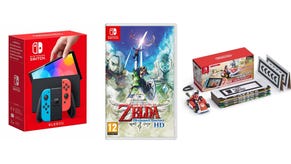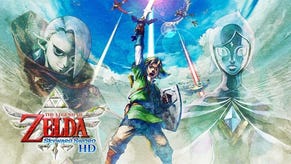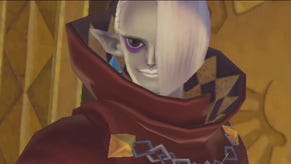Review: The Legend of Zelda: Skyward Sword HD - a cloud-bound romance
Quality of 'Loft.
I'm not sure there is a more magical moment in all of Zelda than the moment you first hit a timeshift stone. For five minutes or so you've been exploring a dead world of greys and browns, moving through empty tunnels, dodging odd lumpen statues, and shoving heavy mine carts ahead of you to make progress. Then you hit the magical stone that stands in the middle of a plaza, and a bright bubble emerges. And within that bubble everything is different. The brown stones around you are now brightly painted. Nearby statues of slumped robots return to fizzing, bickering life - in truth they were never statues at all. Dead plants sprout hearts for you to take, and those mine carts now hum with energy and ghost along on electrical tracks.
I never really get over this moment. But in The Legend of Zelda: Skyward Sword HD, a rerelease of the Wii original from 2011, it was doubly special for me. Because this is the point I switched from handheld mode to playing on the big TV.
This is a remaster based around generous tweaks and "quality-of-life" updates, so it feels right to talk about the controls from the off. The original Skyward Sword was a Wii game to the hilt - literally, as you had to negotiate with your surroundings every time you wanted to swing your Wii Remote sword, while enemies lined up to block attacks if you opted for the wrong angle. These controls never really clicked for me - and quite a lot of other people, reading around the internet. So one of the things I was most excited about with the HD remaster was the option to play the game using button controls.
Partly, this was down to the perverse joy of having a whole Zelda world squeezed down onto a handheld. Game devices you hold in your hand still retain a touch of magic, of dazzle, and there is something pretty special about sitting on a bus while simultaneously exploring a volcanic mountaintop with a glossy talking sword. But the button controls aren't quite what I had hoped for. What they feel like - and this feels odd to say of a Nintendo game - is the very best that the team could do given the circumstances.
The sword is the main stickler for me. Because directional swipes are so fundamental to the game, you can't put sword attacks on a button. Instead, and this is clever for sure, they sit on the right stick - flick up, down, left, right, diagonal to strike, and push up to hold the sword aloft and charge it. Problems: firstly, for me at least, and granted my fingers probably shake a bit more than most people's do, there was just enough input confusion to make more hectic fights feel like a bodge. Secondly, with hovering threat of intermittent drift and an aging console, I didn't really feel too hyped about flicking the thumbstick around with the inevitable force that I would fall into using so regularly for twenty-odd hours. More than that, being dumb, I would often forget the camera wasn't on the thumbstick, so Link would constantly be drawing his sword. I appreciate my mind is more muddled than most, but this never really felt engaging or precise.
And those camera controls only muddled me a bit more, actually. Skyward Sword HD now allows you to control the camera, which is a real improvement on the original game. But with the sword on the right stick - the shield, I should add, is a click of the left - if you want to move the camera you now need to hold down L and move the thumbstick simultaneously. This works fine (and yes, you can use motion controls for the camera, even if it quickly becomes a faff) but it was still another thing to think about, and Skyward Sword can get pretty busy, pretty filled with things to think about. I suspect if I had put in more time with this set-up it would have straightened out in my head, but it always felt like a cludge to me. Crucially, the button controls never really seemed that much fun to use.
If that was a surprise of sorts, motion controls were too. Suddenly, I really love them. I am at a loss to explain why they suddenly delight me so much, but they seem brisk and forgiving, and while the gyro loses itself semi-regularly in busy moments (after the last few years I can empathise with the gyro), a quick point of the right Joy-Con at the screen and a press of Y to recalibrate whenever the system got confused is all it takes to put you back on track. It works as you'd expect: sword (and camera control) on the right Joy-Con and shield on the left. For the first time I was really able to enjoy the game's battles, particularly that first boss encounter in which you must not just strike but fake-out your opponent and lead them in the wrong direction. And for the first time I was able to enjoy the other bits of motion-control business that the game offers. Turning 3D puzzle keys to put them in locks. Moving Link's Loftwing bird through the sky. That funny bit where you basically putt little electrical charges into holes to open doors. Throwing bombs or bowling bombs - I found this particularly tricky with the button set-up - was suddenly a delight.
I appreciate the Wii version probably worked better than I remember it working (just as I appreciate that the buttons probably make more sense for a lot of people than they did for me) but that's the point I think - I still remember this as the Zelda in which the controls felt like a sheet of glass separating me from proper immersion in the adventure. Coming from the series that invented Z-trigger targeting, which always seems so utterly innate, it was always a bit of a shame. In truth, motion controls still leave me subtly removed from the heart of the action here, but I feel a lot closer to it anyway on Switch. (Just be warned: if you're playing on a Switch Lite - and why wouldn't you, it's a gorgeous machine - you are going to be stuck with buttons. Not a disaster, but not ideal if you ask me.)
Moving beyond controls, I should probably add that I have been playing Skyward Sword HD with two different opinions rattling in my head. One is from a friend who adores this Zelda above all competitors, above all other games. The other is a friend who replayed the Wii version recently and loathed every minute of it. This posed a question to me. Since the Daedalian thrills of Link to the Past - the absolute best Zelda, no backsies - I have always tried to approach Zelda games as puzzles in themselves. Here I would argue, the real puzzle is a question of reputation. Is Skyward Sword a great Zelda game or not?

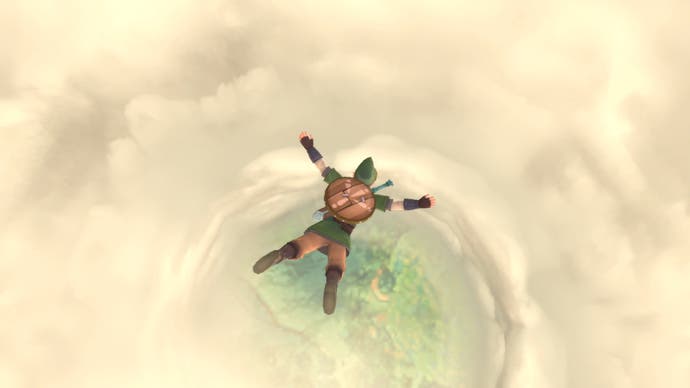

This is certainly the best chance you'll get to answer that question fairly. Alongside the control options, there have been a lot of tweaks to make things smoother. Alongside different save slots, the game now auto-saves from time to time, which means no more trudging back to a save point - annoying as this was, in a way, I feel like this might be missing the point somewhat, Skyward Sword's bird statues coming across a bit like the point where you have to turn an LP over halfway: a limitation that becomes a cherished ritual. Elsewhere, the tutorials have been streamlined and Fi, the talking sword, no longer interrupts you so frequently, just as you're no longer interrupted with an explanation when you pick up an object you've already picked up before. Fi can now be summoned for additional help when you're stuck, and the game runs at 60 fps. Oh, and you can skip cutscenes and fast-forward dialogue.
Crucially the whole thing's been given an HD upgrade. I had misgivings about how Skyward Sword's feathery, impressionist art style would work in HD - if any game was made for the migraine aura of a good blurry CRT it's this one - but it's been a delight. This is a beautiful game, and it retains its beauty, while clearly being a decade old: in a way that only adds to it. The colours are straight out of Cezanne and the textures feel dappled with individual dabs of the paintbrush. Character models are wonderfully odd with their exaggerated faces, and the game's central hub, the floating town of Skyloft, is an absolute delight. I'm not sure if I have a more favourite location in any game outside of Wind-Waker, from the lonely promontories to the gorgeous multi-colour bazaar where you can upgrade items and buy new ones, or simply enjoy the sense of being in a huge, chummy tent.
I remember loving Skyloft back in the day. I was slightly more concerned about what lay beyond it. In my mind, Skyward Sword is a game with beautiful, compact, imaginative dungeons and a slightly drab trudge between them. Playing now, I'm not sure this is correct.
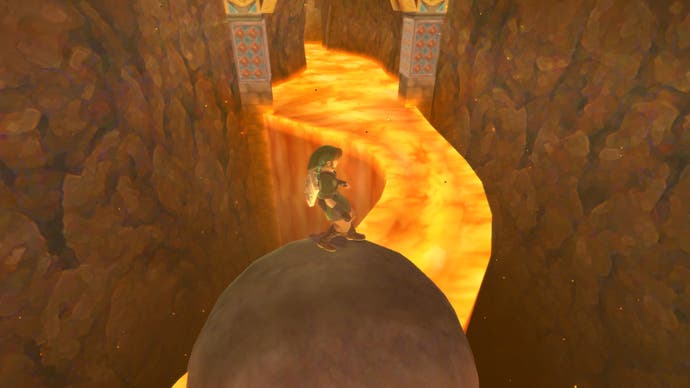
The dungeons are certainly lovely - a real highlight, starting off with the spooky, cobwebby church ruins of the Skyview Temple and scaling in inventiveness and playfulness until some of them don't really feel like dungeons at all. The items collected are classics - I'm particularly fond of the sort of vacuum cleaner you get, which you can actually use for vacuum cleaning in a side-quest - and there are some really excellent boss fights, one of which involved sand physics so pleasing I sort of let it beat me a couple of extra times just to enjoy them.
Beyond that, things are often better than I remembered. The different environments you visit while hunting for dungeons are far more varied than I recalled. There are only three main locations per se, but each time you return they show very different aspects of themselves. There is a lot of padding and repetition, but even then the game is willing to throw in mini-games like a stealthy treasure hunt that other developers would probably be tempted to spin off into its own release. Ultimately, moving between forest and desert and mine, Skyward Sword feels like the most Metroidy of Zelda games - Link has never been more like a sewing needle, finding new patterns in familiar cloth.
That's great, but the sky itself is still a bit of a disappointment. In between exploring the world below the clouds and rummaging around temples, Link travels between floating chunks of rock, riding on the back of a Loftwing bird. I think the concept of a forgotten world beneath the clouds is so lovely that it justifies this idea, but I still struggle to have much fun up here. Elements that you summon by hitting blocks in the world below give the place a sort of Panini sticker book feel - lots of tempting, maddening absences, got, got need - and there are couple of really lovely islands to visit, not least the one where I always feel bad about knocking down the chandelier and getting yelled at. But the whole thing never quite comes into focus, never feels like an end in itself in the same way that the Great Sea did in The Wind Waker did for me. For me, that sea was a place to be in its own right, its blue surface always dancing with white caps, its horizon always shifting. The sky is always a thing that lies between places and the Loftwing is merely the way you navigate it a lot of the time. What strikes me most now is actually how disconnected it all feels from the world on the ground and in Skyloft, despite a few attempts to bring the game's various elements together. More than any other Zelda, Skyward Sword is a game of individual parts.
Those parts though. What's fascinating when you play Skyward Sword in 2021, is knowing what came next. For all that empty space above the clouds, Skyward Sword is so intricate on the ground, broken down into little maps, little challenges, the next bit of business, that it can feel like the least roomy of Zeldas. It's brilliant, but fractal-tight in its binding up of its clever ideas. Even with the quality-of-life changes, it feels like the most stop-start Zelda there is, filled with interruptions and transitions. Save for a few very memorable moments, what's missing, I think, is space, space filled with things to look around, actual places to feel like you are visiting without the compulsion of a specific objective - and when I think of Breath of the Wild, it's that kind of space that comes to mind first. Skyward Sword doesn't have much of the kind of space that encourages the many pleasures of solitude, which always feel like very Zelda-ish pleasures.
You can see with Skyward Sword that something has to change. See it in the way it tentatively messes with the formula, but ultimately retains one of the most rigid central paths of any Zelda. In the way it introduces stuff like the stamina gauge, which will make much more sense in the game that follows it. It's clear now that Skyward Sword is straining against its own rules and rituals. That makes it fascinating to play, and it means that this strangest and most compromised of Zeldas is also amongst the most human.






